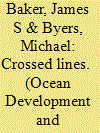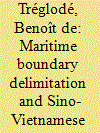| Srl | Item |
| 1 |
ID:
110842


|
|
|
|
|
| Publication |
2012.
|
| Summary/Abstract |
The Beaufort Sea maritime boundary dispute has traditionally been understood as involving a wedge-shaped area of maritime space that extends to a distance of 200 nautical miles north of the terminus of the Canada-United States border between the Yukon Territory and Alaska. However, new data collected in pursuit of establishing the limits of the extended continental shelf in the region show that the two countries' seabed resource rights may stretch far beyond the 200-nautical-mile limit of the exclusive economic zone. Significantly, at approximately 200 nautical miles from shore, the U.S.-claimed equidistance line crosses the line claimed by Canada, which follows the 141° W meridian, meaning that the legal positions of the two countries if simply extended beyond the EEZ would appear to favor the other party. This article explores how the United States and Canada might seek to reformulate their legal positions to resolve the dispute. Though these reformulated positions might not reduce the area in dispute, they will clarify it and potentially enable the parties to either delimit a single maritime boundary or choose to implement one of a number of creative solutions to the dispute that are outlined in the article.
|
|
|
|
|
|
|
|
|
|
|
|
|
|
|
|
| 2 |
ID:
167523


|
|
|
|
|
| Summary/Abstract |
This article analyzes a little-noticed aspect of the international legal controversy pertaining to Svalbard’s maritime zones. It concerns where and by which method Norway should draw the boundaries between Svalbard’s continental shelf and the 200-mile zone, on the one hand, and other maritime zones subject to Norwegian jurisdiction, on the other. The assumption upon which the discussion rests is that the Spitsbergen Treaty signatories enjoy treaty rights in the maritime zones beyond Svalbard’s territorial waters. The law of the sea does not contain rules on the drawing of maritime boundaries between different parts of a state’s territory, but the rules on delimitation between states offer a strong analogy. In the search for an equitable solution, primacy should be given to geographical factors. The article argues that Norway could do more to enhance the openness regarding the Svalbard delimitation question since its outcome will be of significant interest to other states.
|
|
|
|
|
|
|
|
|
|
|
|
|
|
|
|
| 3 |
ID:
165117


|
|
|
|
|
| Summary/Abstract |
The final judgment in the maritime boundary delimitation case between Ghana and Côte d’Ivoire was delivered by an ad hoc special chamber (the Chamber) of the International Tribunal for the Law of the Sea (ITLOS) on 23 September 2017. The decision addressed important legal questions relating not only to maritime boundary delimitation but also to the balancing of various rights and interests at the provisional measures stage and international responsibility for unilateral resource exploitation activities in disputed zones pending delimitation. This article analyzes the decision of the Chamber with respect to its findings on tacit boundary agreements, delimitation methodology, and international responsibility.
|
|
|
|
|
|
|
|
|
|
|
|
|
|
|
|
| 4 |
ID:
147842


|
|
|
|
|
| Summary/Abstract |
Since the rapprochement between China and Vietnam in 1991, Beijing and Hanoi have always sought to compartmentalise their territorial disputes. As a result, the upsurge of tensions in the South China Sea since 2011 has only affected their bilateral partnership to a limited extent, as the two countries continue to observe the Gulf of Tonkin agreements that were signed in December 2000, establishing their first maritime border in the waters of the Gulf as well as cooperation in matters of fishing, hydrocarbon exploration, and maritime security. This article intends to take stock of the first 16 years of Sino-Vietnamese cooperation in the Gulf of Tonkin, before exploring the potential progress that could represent the current negotiations between the two states regarding the delimitation of the “mouth” of the Gulf, located off the Paracel Islands.
|
|
|
|
|
|
|
|
|
|
|
|
|
|
|
|
| 5 |
ID:
145657


|
|
|
|
|
| Summary/Abstract |
The application of the principle of non-cut off is a significant tool in maritime delimitation to provide an equitable solution. Unfortunately, scholars and experts have paid scant attention to this principle of maritime delimitation. This article analyzes the growing role of the principle of non-cut off in the law of maritime boundary delimitation and examines the related jurisprudence on the issue.
|
|
|
|
|
|
|
|
|
|
|
|
|
|
|
|
| 6 |
ID:
124568


|
|
|
|
|
| Publication |
2013.
|
| Summary/Abstract |
The International Tribunal on the Law of the Sea's March 2012 Judgment in the Bay of Bengal Case is a landmark decision in multiple ways. It represents the first maritime boundary to be delimitated by the Tribunal. It is the first adjudication of a maritime boundary in Asia, and it is also the first judicial delimitation of a maritime boundary for parts of the extended continental shelf located seaward of the 200-nautical-mile limit from baselines. While the Tribunal's ruling largely resolves the maritime dispute between Bangladesh and Myanmar, it also raises a number of questions and concerns that are highlighted in this article, including the Tribunal's approach to delimitation both within and beyond the 200-nautical-mile limit, the treatment of islands, the interplay between law of the sea institutions and the creation of a so-called grey area where continental shelf jurisdiction falls to one state and water column jurisdiction to the other.
|
|
|
|
|
|
|
|
|
|
|
|
|
|
|
|